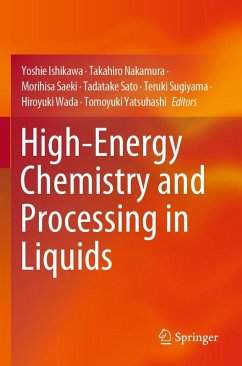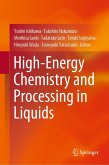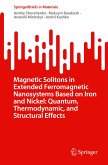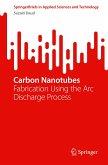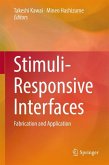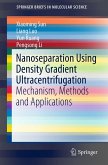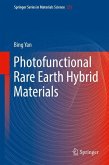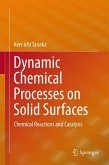High-Energy Chemistry and Processing in Liquids
Herausgegeben:Ishikawa, Yoshie; Nakamura, Takahiro; Saeki, Morihisa; Sato, Tadatake; Sugiyama, Teruki; Wada, Hiroyuki; Yatsuhashi, Tomoyuki
High-Energy Chemistry and Processing in Liquids
Herausgegeben:Ishikawa, Yoshie; Nakamura, Takahiro; Saeki, Morihisa; Sato, Tadatake; Sugiyama, Teruki; Wada, Hiroyuki; Yatsuhashi, Tomoyuki
- Broschiertes Buch
- Merkliste
- Auf die Merkliste
- Bewerten Bewerten
- Teilen
- Produkt teilen
- Produkterinnerung
- Produkterinnerung
This book focuses on chemical reactions and processing under extreme conditions-how materials react with highly concentrated active species and/or in a very confined high-temperature and high-pressure volume. Those ultimate reaction environments created by a focused laser beam, discharges, ion bombardments, or microwaves provide characteristic nano- and submicron-sized products and functional nanostructures. The book explores the chemistry and processing of metals and non-metals as well as molecules that are strongly dependent on the energy deposition processes and character of the materials.…mehr
Andere Kunden interessierten sich auch für
![High-Energy Chemistry and Processing in Liquids High-Energy Chemistry and Processing in Liquids]() High-Energy Chemistry and Processing in Liquids119,99 €
High-Energy Chemistry and Processing in Liquids119,99 €![Magnetic Solitons in Extended Ferromagnetic Nanosystems Based on Iron and Nickel: Quantum, Thermodynamic, and Structural Effects Magnetic Solitons in Extended Ferromagnetic Nanosystems Based on Iron and Nickel: Quantum, Thermodynamic, and Structural Effects]() Andriy ShevchenkoMagnetic Solitons in Extended Ferromagnetic Nanosystems Based on Iron and Nickel: Quantum, Thermodynamic, and Structural Effects34,99 €
Andriy ShevchenkoMagnetic Solitons in Extended Ferromagnetic Nanosystems Based on Iron and Nickel: Quantum, Thermodynamic, and Structural Effects34,99 €![Carbon Nanotubes Carbon Nanotubes]() Suzairi DaudCarbon Nanotubes34,99 €
Suzairi DaudCarbon Nanotubes34,99 €![Stimuli-Responsive Interfaces Stimuli-Responsive Interfaces]() Stimuli-Responsive Interfaces75,99 €
Stimuli-Responsive Interfaces75,99 €![Nanoseparation Using Density Gradient Ultracentrifugation Nanoseparation Using Density Gradient Ultracentrifugation]() Xiaoming SunNanoseparation Using Density Gradient Ultracentrifugation41,99 €
Xiaoming SunNanoseparation Using Density Gradient Ultracentrifugation41,99 €![Photofunctional Rare Earth Hybrid Materials Photofunctional Rare Earth Hybrid Materials]() Bing YanPhotofunctional Rare Earth Hybrid Materials97,99 €
Bing YanPhotofunctional Rare Earth Hybrid Materials97,99 €![Dynamic Chemical Processes on Solid Surfaces Dynamic Chemical Processes on Solid Surfaces]() Ken-ichi TanakaDynamic Chemical Processes on Solid Surfaces90,99 €
Ken-ichi TanakaDynamic Chemical Processes on Solid Surfaces90,99 €-
-
-
This book focuses on chemical reactions and processing under extreme conditions-how materials react with highly concentrated active species and/or in a very confined high-temperature and high-pressure volume. Those ultimate reaction environments created by a focused laser beam, discharges, ion bombardments, or microwaves provide characteristic nano- and submicron-sized products and functional nanostructures. The book explores the chemistry and processing of metals and non-metals as well as molecules that are strongly dependent on the energy deposition processes and character of the materials. Descriptions of a wide range of topics are given from the perspective of a variety of research methodologies, material preparations, and applications. The reader is led to consider and review how a high-energy source interacts with materials, and what the key factors are that determine the quality and quantity of nanoproducts and nano-processing.
Produktdetails
- Produktdetails
- Verlag: Springer / Springer Nature Singapore / Springer, Berlin
- Artikelnr. des Verlages: 978-981-16-7800-4
- 1st edition 2022
- Seitenzahl: 364
- Erscheinungstermin: 7. Februar 2023
- Englisch
- Abmessung: 235mm x 155mm x 20mm
- Gewicht: 552g
- ISBN-13: 9789811678004
- ISBN-10: 9811678006
- Artikelnr.: 67271385
- Herstellerkennzeichnung Die Herstellerinformationen sind derzeit nicht verfügbar.
- Verlag: Springer / Springer Nature Singapore / Springer, Berlin
- Artikelnr. des Verlages: 978-981-16-7800-4
- 1st edition 2022
- Seitenzahl: 364
- Erscheinungstermin: 7. Februar 2023
- Englisch
- Abmessung: 235mm x 155mm x 20mm
- Gewicht: 552g
- ISBN-13: 9789811678004
- ISBN-10: 9811678006
- Artikelnr.: 67271385
- Herstellerkennzeichnung Die Herstellerinformationen sind derzeit nicht verfügbar.
Yoshie Ishikawa has been a senior researcher at the National Institute of Advanced Industrial Science and Technology (AIST) since 2013. She received her Ph.D. from Kumamoto University in 2003 and was an associate professor in Kagawa University until 2013. Her scientific focus is on the fabrication and application of pulsed laser melting in liquids for metallic and inorganic sub-micrometer particle synthesis. Takahiro Nakamura is a graduate of Tohoku University, where he received his doctorate under the guidance of Prof. Eichiro Matsubara in 2004. He began his academic career as an assistant professor in 2005 at the Institute of Multidisciplinary Research for Advanced Materials, Tohoku University. He now is an associate professor at the same institute. His current research interests are laser materials processing, especially the generation of metal and/or alloy nanoparticles by high-intensity ultra-short pulse laser irradiation in liquids. Morihisa Saeki graduated from The University of Tokyo and received his doctorate there under the guidance of Prof. Takashi Nagata in 1999. He has been a senior researcher in the National Institutes for Quantum and Radiological Science and Technology since 2016. He was a visiting scientist at the Institute of Radiochemistry, Helmholtz-Zentrum Dresden-Rossendorf (Germany) in 2010. His current research interests are the application of laser-induced particle formation in liquids and elucidation of its mechanism using time-resolved X-ray absorption spectroscopy. Tadatake Sato is a graduate of Kyoto University, where he completed his doctorate under the guidance of Prof. Kazuyoshi Tanaka in 1998. He now is a researcher at the National Institute of Advanced Industrial Science and Technology (AIST). His current research interests are laser processing of various materials using unique laser-induced phenomena. Teruki Sugiyama received his doctoratefrom Nankai University, China, under the supervision of Professors Teruo Matsuura and Jiben Meng in 2002. He has been a professor of applied chemistry at the College of Science, National Chiao Tung University since 2020. His research group has explored the possibility of high-energy laser-based phenomena such as optical tweezers and laser ablation in molecular/cluster systems. He has been particularly devoted to applying the optical tweezers method to crystal chemistry, and his group received the Best Paper Award from the Japanese Association for Crystal Growth (JACG) for their paper entitled "Control of Amino Acid and Protein Crystallization by Optical Trapping" in 2018. Hiroyuki Wada is an associate professor in the Department of Chemical Science and Engineering, School of Materials and Chemical Technology, Tokyo Institute of Technology (2005 - present). His research is related to optical nanoparticles. He received the B. Eng. in 1990 and the M. Eng. in1992 from the Tokyo Institute of Technology. He was a researcher for Sony Corp. and investigated lasers and laser processes (1992-2005). He was a visiting researcher at Stanford University (USA) in 2001. He received the D. Eng. degree in 2003 from the Tokyo Institute of Technology, and he was a visiting professor at Carnegie Mellon University (USA, 2006-2007). Tomoyuki Yatsuhashi graduated from the Tokyo Metropolitan University, where he received his doctorate under the guidance of Prof. Haruo Inoue in 1998. He has been a professor of chemistry in the Graduate School of Science, Osaka City University, since 2011. He was a visiting scientist in Germany at the Max-Planck-Institut für Quantenoptik (Alexander von Humboldt Foundation Research Fellowship, 2002-2003). In 2009, he was selected as a researcher of the Precursory Research for Embryonic Science and Technology Program of the Japan Science and Technology Agency. His current research interests are high-energy chemistry in the liquid phase and the photophysics and photochemistry of multiply charged molecular cations.
Part I: High-energy chemistry and processing of metals.- 1. Laser-induced bubble generation on excitation of gold nanoparticles.- 2. Metal and alloy nanoparticles formed by laser-induced nucleation method.- 3. Laser-induced reduction and particle formation of precious metal ions in a solution: Application to metal recovery.- 4. Synthesis of metal nano-particles induced by plasma-assisted electrolysis.- 5. Controllable surface modification of colloidal nanoparticles using laser ablation in liquids and its utilization.- Part II: High-energy processing of nonmetals.- 6. Fabrication and control of semiconductor random lasers using laser processing techniques.- 7. Formation mechanism of spherical submicrometer particles by pulsed laser melting in liquid.- 8. Mass production of spherical submicrometer particles by flow-style pulsed laser melting in liquid.- 9. Material processing for colloidal silicon quantum dot formation.- 10. Processing of transparent materials using laser-induced high-energy state in liquid.- 11. Functional nanomaterial and nanostructure synthesized by femtosecond laser pulses.- 12. Preparation of functional nanoparticles by laser process in liquid and their optical applications.- Part III: High-energy chemistry of nonmetals.- 13. Nanoscale transient laser heating and the related chemical process of organic solid.- 14. Fundamentals and applications of novel high-energy reaction fields by microwave chemistry.- 15. Study on the preparation and photocatalytic activity of the laser modified photocatalysis.- 16. Control of crystallization by intense focused laser beam.- 17. Electrocatalysts developed from ion-implanted carbon materials.- 18. Carbon nanoparticle production in plasma filaments generated by intense femtosecond laser pulses.
Part I: High-energy chemistry and processing of metals.- 1. Laser-induced bubble generation on excitation of gold nanoparticles.- 2. Metal and alloy nanoparticles formed by laser-induced nucleation method.- 3. Laser-induced reduction and particle formation of precious metal ions in a solution: Application to metal recovery.- 4. Synthesis of metal nano-particles induced by plasma-assisted electrolysis.- 5. Controllable surface modification of colloidal nanoparticles using laser ablation in liquids and its utilization.- Part II: High-energy processing of nonmetals.- 6. Fabrication and control of semiconductor random lasers using laser processing techniques.- 7. Formation mechanism of spherical submicrometer particles by pulsed laser melting in liquid.- 8. Mass production of spherical submicrometer particles by flow-style pulsed laser melting in liquid.- 9. Material processing for colloidal silicon quantum dot formation.- 10. Processing of transparent materials using laser-induced high-energy state in liquid.- 11. Functional nanomaterial and nanostructure synthesized by femtosecond laser pulses.- 12. Preparation of functional nanoparticles by laser process in liquid and their optical applications.- Part III: High-energy chemistry of nonmetals.- 13. Nanoscale transient laser heating and the related chemical process of organic solid.- 14. Fundamentals and applications of novel high-energy reaction fields by microwave chemistry.- 15. Study on the preparation and photocatalytic activity of the laser modified photocatalysis.- 16. Control of crystallization by intense focused laser beam.- 17. Electrocatalysts developed from ion-implanted carbon materials.- 18. Carbon nanoparticle production in plasma filaments generated by intense femtosecond laser pulses.

